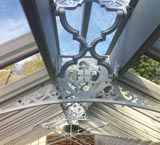How big should your greenhouse be?
Greenhouses can be expensive but they’re also very necessary come winter. What size is the perfect greenhouse?


How pleasant, in January, to recall last year's wonderful summer. Olean-ders, argyranthemums and other subtropical beauties flourished outside until November and might have survived longer, had we lived in the South-West. But Lincolnshire winters take no prisoners.
Our collection of tender plants has therefore to be overwintered ‘under glass'. That term, coined by experts of earlier times, means anything from a cloche to the Kew Palm House. The glass of one's dreams would be an enormous conservatory with cost-free heating, plenty of headroom and enough floor space to accommodate a suburban Sydney garden.
In real life, our ‘glass' consists of one greenhouse measuring 15ft by 8ft and kept above 4˚C. We have too little space for all our treasures, so each summer concludes with a frenzy of propagation, ferocious pruning and the cramming of big roots into small pots.
The term ‘treasures' refers not to rarities, but to plants that matter for more personal reasons. Some, such as a special form of Plectranthus ciliatus, were gifts we're honour-bound to keep alive.
My brother, who has no glass, entrusts me not merely to overwinter his favourites, but also to propagate new ones. Then, there are plants promised-perhaps in moments of Pimm's-inspired summer largesse-to friends who envy the fragrance of an old heliotrope or long to have ‘one of those quaint-looking Aeonium things'.
Our garden relies heavily on tender summer plants. Two terraces-one south-facing, the other best for evening sun-are badly over-paved. Soon after moving here, we levered out as many slabs as we could to create planting opportunities, but there is still too much hard landscaping. The low walls and remaining paving, although not ugly, look better when softened with leafiness and colour; for that, we need sprawlers. Tumbling Bidens ferulifolia, big-flowered, floppy lobelias, trailing antirrhinums-such plants are easy to propagate, but they demand considerable greenhouse space, especially in spring, when they run but can't yet be risked outdoors.
Above all, this one has to accommodate the incurable jackdaw habits of its owner. Botanical obsessions usually result in collections and if the plants are tender, they will need winter protection. The current craze is for Pelar-gonium species. The first I ever saw wild, P. abrotanifolium, was on Paarl Mountain in the Western Cape. Modestly beautiful, with aro-matic grey-green filigree leaves and tiny white flowers, this was among 50 pelargonium species first collected by Francis Masson, who sailed to South Africa with Capt Cook in 1772.
Exquisite houses, the beauty of Nature, and how to get the most from your life, straight to your inbox.
Such plants conjure up joyous memories. When Pelargonium fulgidum blooms here, my mind revisits a patch of sandy bush in Africa, where the scarlet flowers made a dazzling contrast with drifts of the intense blue annual Heliophilus. Luckily, interesting pelargoniums like these can be sourced in the UK and are listed in the RHS Plant Finder (www.rhs.org.uk/plants). But how does one accommodate all that tender material in a little greenhouse? If the plant collections are to remain healthy, stock plants must be over-wintered and new cuttings propagated. A building twice the size would be crowded.
Space is also taken up by the 10sq ft propagating bench and the staging that carries masses of rooted cuttings. These will need potting up at least once and must be grown on for next summer. Most will increase their size at least five fold, but will not be safe to move outside until mid May. Oh, and in February, there will be seeds to sow, leading to extra pots and cell trays needing yet more space.
If we built a second greenhouse tomorrow, it would fill instantly and, by next January, we'd be in exactly the same position, but with double the heating bill. Some ‘glass' is essential, but there can never be enough.
Nigel Colborn is a former farmer and now cultivates a wildlife-oriented garden in Lincolnshire
* Follow Country Life on Twitter
* Subscribe to Country Life and save up to 40% in our January sale
Country Life is unlike any other magazine: the only glossy weekly on the newsstand and the only magazine that has been guest-edited by His Majesty The King not once, but twice. It is a celebration of modern rural life and all its diverse joys and pleasures — that was first published in Queen Victoria's Diamond Jubilee year. Our eclectic mixture of witty and informative content — from the most up-to-date property news and commentary and a coveted glimpse inside some of the UK's best houses and gardens, to gardening, the arts and interior design, written by experts in their field — still cannot be found in print or online, anywhere else.
